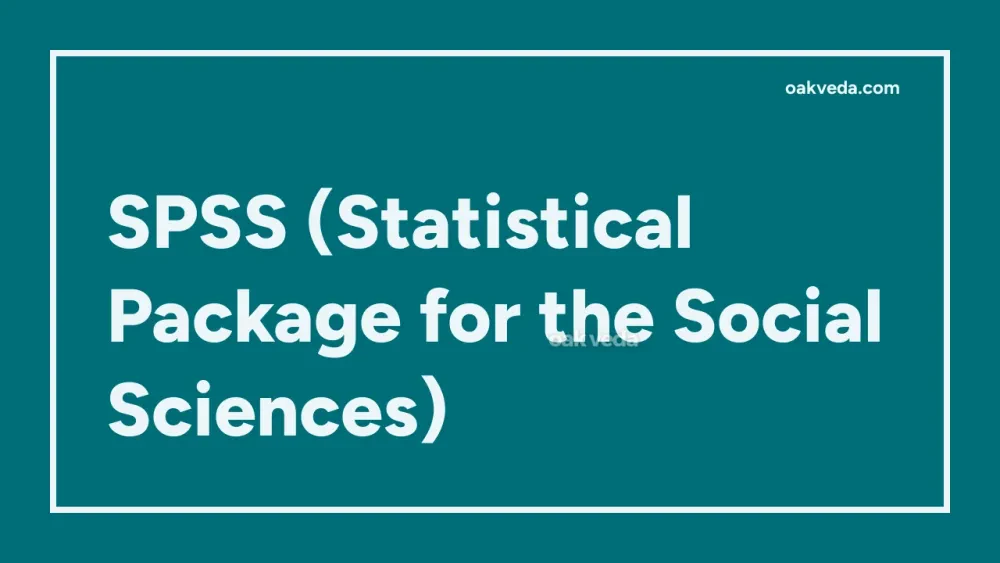
What is the Full Form of SPSS?
SPSS is an acronym that represents the Statistical Package for the Social Sciences. This powerful software suite has become an essential tool for researchers, statisticians, and data analysts across various fields, particularly in social sciences and beyond.
What is Statistical Package for the Social Sciences?
The Statistical Package for the Social Sciences (SPSS) is a comprehensive software platform designed for complex statistical data analysis. It offers a wide range of tools and features that enable users to process, analyze, and interpret large datasets efficiently. While initially developed for social sciences, SPSS has expanded its reach to other disciplines, including health sciences, market research, and business analytics.
Origin and Development of SPSS
The history of SPSS dates back to 1968 when it was first introduced by SPSS Inc. The software was created to address the growing need for statistical analysis tools in social sciences research. Over the years, SPSS has undergone significant developments and changes:
- 1968: SPSS is first published
- 1983: Version 10 (SPSS-X) is released, allowing data sets to involve multiple forms of records
- 2009: IBM acquires SPSS Inc.
- 2010: SPSS becomes a subsidiary of IBM, and the company gains full ownership
Today, SPSS continues to evolve under IBM's leadership, maintaining its position as a leading statistical software package.
How does SPSS work?
SPSS operates as a comprehensive data analysis platform that allows users to perform various statistical operations. The software works by:
- Data Input: Users can import data from various sources or enter it manually.
- Data Preparation: SPSS provides tools for cleaning, organizing, and transforming data.
- Analysis: Users can select from a wide range of statistical tests and procedures.
- Visualization: The software offers options to create charts, graphs, and other visual representations of data.
- Reporting: SPSS generates detailed reports of analysis results.
Functions of SPSS
SPSS offers a diverse set of functions to cater to different analytical needs:
- Descriptive Statistics: Provides measures of central tendency, dispersion, and distribution.
- Inferential Statistics: Enables hypothesis testing, correlation analysis, and regression modeling.
- Data Management: Offers tools for data cleaning, transformation, and merging.
- Data Visualization: Creates various types of charts and graphs for data representation.
- Predictive Modeling: Supports advanced techniques like machine learning and forecasting.
- Text Analysis: Analyzes unstructured data from surveys and open-ended responses.
Applications of SPSS
SPSS finds applications across numerous sectors:
- Academic Research: Used extensively in social sciences, psychology, and education.
- Healthcare: Analyzes clinical trial data and epidemiological studies.
- Market Research: Helps in consumer behavior analysis and trend forecasting.
- Business Intelligence: Supports decision-making through data-driven insights.
- Government: Used in policy analysis and demographic studies.
- Non-profit Organizations: Aids in program evaluation and impact assessment.
Features of SPSS
Key features that make SPSS a preferred choice for many researchers include:
- User-friendly interface with both menu-driven and syntax options
- Comprehensive set of statistical procedures
- Advanced data management capabilities
- Customizable reporting and output options
- Integration with other IBM products and third-party software
- Regular updates and new feature additions
Benefits of SPSS
Using SPSS offers several advantages:
- Efficiency: Streamlines the data analysis process, saving time and effort.
- Accuracy: Reduces the risk of human error in complex calculations.
- Versatility: Applicable to various research designs and data types.
- Scalability: Handles large datasets with ease.
- Reproducibility: Allows for easy replication of analyses.
- Collaboration: Facilitates sharing of data and results among team members.
Limitations or Challenges of SPSS
Despite its strengths, SPSS has some limitations:
- Cost: The software can be expensive, especially for individual researchers or small organizations.
- Learning Curve: Mastering all features requires time and training.
- Limited Customization: Some advanced users may find the customization options restrictive compared to programming languages like R or Python.
- Dependence on IBM: Updates and support are tied to IBM's development cycle.
Future Developments in SPSS Technology
As data analysis continues to evolve, SPSS is likely to see advancements in:
- AI Integration: Incorporating more machine learning and artificial intelligence capabilities.
- Cloud-Based Solutions: Enhancing collaboration and accessibility through cloud platforms.
- Big Data Handling: Improving capabilities to process and analyze extremely large datasets.
- Real-Time Analytics: Developing features for instant data processing and analysis.
- Integration with Emerging Technologies: Adapting to work with IoT devices and other data sources.
FAQs on SPSS Full Form
-
What does SPSS stand for? SPSS stands for Statistical Package for the Social Sciences.
-
Is SPSS only for social sciences? No, while it originated in social sciences, SPSS is now used across various fields including health sciences, market research, and business analytics.
-
Who owns SPSS now? SPSS is currently owned by IBM, following its acquisition in 2009.
-
Can SPSS handle qualitative data? Yes, SPSS has features for analyzing qualitative data, particularly through its Text Analytics module.
-
Is SPSS suitable for beginners? SPSS has a user-friendly interface that can be suitable for beginners, but mastering all its features may require some training.
In conclusion, the Statistical Package for the Social Sciences (SPSS) has evolved from a specialized tool for social scientists to a versatile data analysis platform used across multiple disciplines. Its comprehensive features, user-friendly interface, and powerful analytical capabilities make it a valuable asset for researchers and analysts worldwide. As data continues to play an increasingly crucial role in decision-making processes, SPSS is likely to remain at the forefront of statistical analysis software, adapting to new challenges and technological advancements.
You may be interested in:

